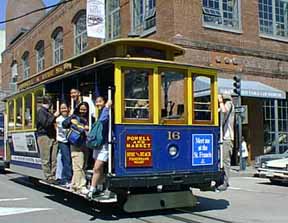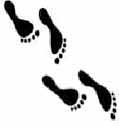 |
HERE WE GO!
Follow the footsteps for
a brief tour. This is an Internet view of some of the historical
treasures you will find when you visit the Cable Car Museum in person!
The Museum, located in the
Washington and Mason cable car barn and powerhouse, is free and
is open every day except Thanksgiving, Christmas and New Years day
from 10:00 a.m. to 6:00 p.m. (October through March to 5:00 p.m.).
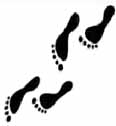
|
|
Museum goers have the choice of visiting
the observation gallery or descending to the sheave (pronounced
"shiv") room to view the system's underground cables.
|
|
 |
 |
Descending to the sheave
room, visitors pass historic displays. |
In the sheave room, visitors can observe
a part of the system's labyrinth of tunnels, cables and sheaves (pulleys)
through the viewing windows.
|
 |
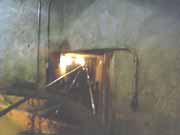 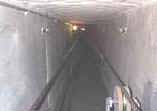 |
Sheaves guide the system's cables under the
streets of San Francisco.
|
Ascending to the observation gallery,
visitors pass under the Cable Car Museum arch.
|
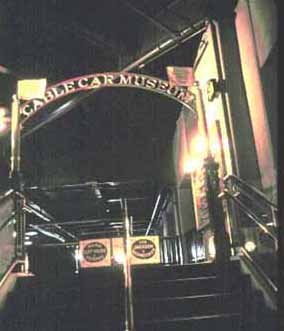 |
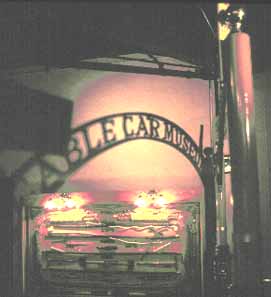 |
The Museum lighting creates
unique perspectives on many of the exhibits.
|
Located at the top of the stairs is the front
end of an original Powell Street cable car, which unlike today's cars
did not have front windows.
|
 |
 |
A Museum designed banner, celebrating
125 years of cable car service.
|
| Clay Street Hill Railroad's
grip car No. 8, dating from the 1870s, was a part of the fleet operated
on Andrew Smith Hallidie's Clay Street Hill Railroad. |
 |
 |
Visitors soon discover they have entered
not only into a museum, but an operating power house. The source of
the background noises can be seen by going to the rail of the observation
gallery. |
To keep the cable from slipping as it is
powered each cable wraps 3/4 around its powered driving sheave and
under and over an unpowered idler sheave, in a figure-8 pattern.
|
 |
 |
Each cable has its own drive machinery -
a 510-horsepower DC electric motor, gears to reduce the speed of the
motor to the proper cable speed of 9 1/2 miles per hour.
|
The cable winding machinery
floor.
|
 |
 |
Grip car No. 46, built in the late 1870s,
saw service until 1929 on the Pacific Avenue Line. |
Trailer No. 54 has been repainted back to
the Sutter Street Railway paint scheme.
|
 |
 |
Until 1883, all cable car service was supplied
by cable car trains consisting of a grip car and trailer. Nos.
46 and 54 began their service in the 1870s for Sutter Street Railroad.
|
The cable car system was entirely rebuilt
between September 1982 and June 1984, as depicted in this photographic
display. |
 |
 |
Historic photographs are found under a sign
from Andrew Hallidie's California Wire Rope Works. |
After the 1906 Earthquake and Fire electric
streetcars replaced many cable car lines. A large model of a California
Comfort Car with an Art Deco paint scheme is featured in this display.
|
 |
 |
A Museum-designed mural depicts the famous
Powell & Market turntable during the 1947 unsuccessful battle
to replace the Powell Street cable cars with buses. |
Visitors sit in cable car to watch a video
that explains how the cable car system works. |
 |
 |
The flavor of San Francisco's colorful cable
car past is captured in the Museum's cable car model collection.
|
The craftsmanship of the Museum's model collection
is illustrated by this close up view. |
 |
 |
The ambiance of 19th-century San Francisco
and its cable car systems can be seen in many of the Museum's historic
photographs. |
Prior to today's system of numbered tickets,
companies required conductors to ring up all fares on large fare registers
to prevent them from pocketing the money. |
 |
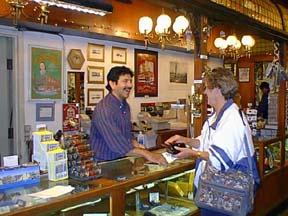 |
The Museum's well-stocked
bookstore features a wide variety of cable car and San Francisco items.
|
On the floor above the observation gallery
is the storage barn for the City's cable car fleet. Visitors may look
into the storage area from either the Washington or Jackson Street
sidewalks.
|
 |
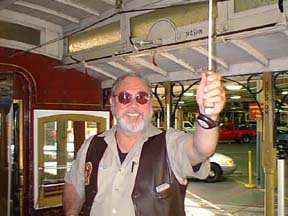 |
The ringing of the cable
car bell is one of San Francisco's most familiar and favorite sounds.
You can ring a genuine cable car bell in the Museum!
 |
